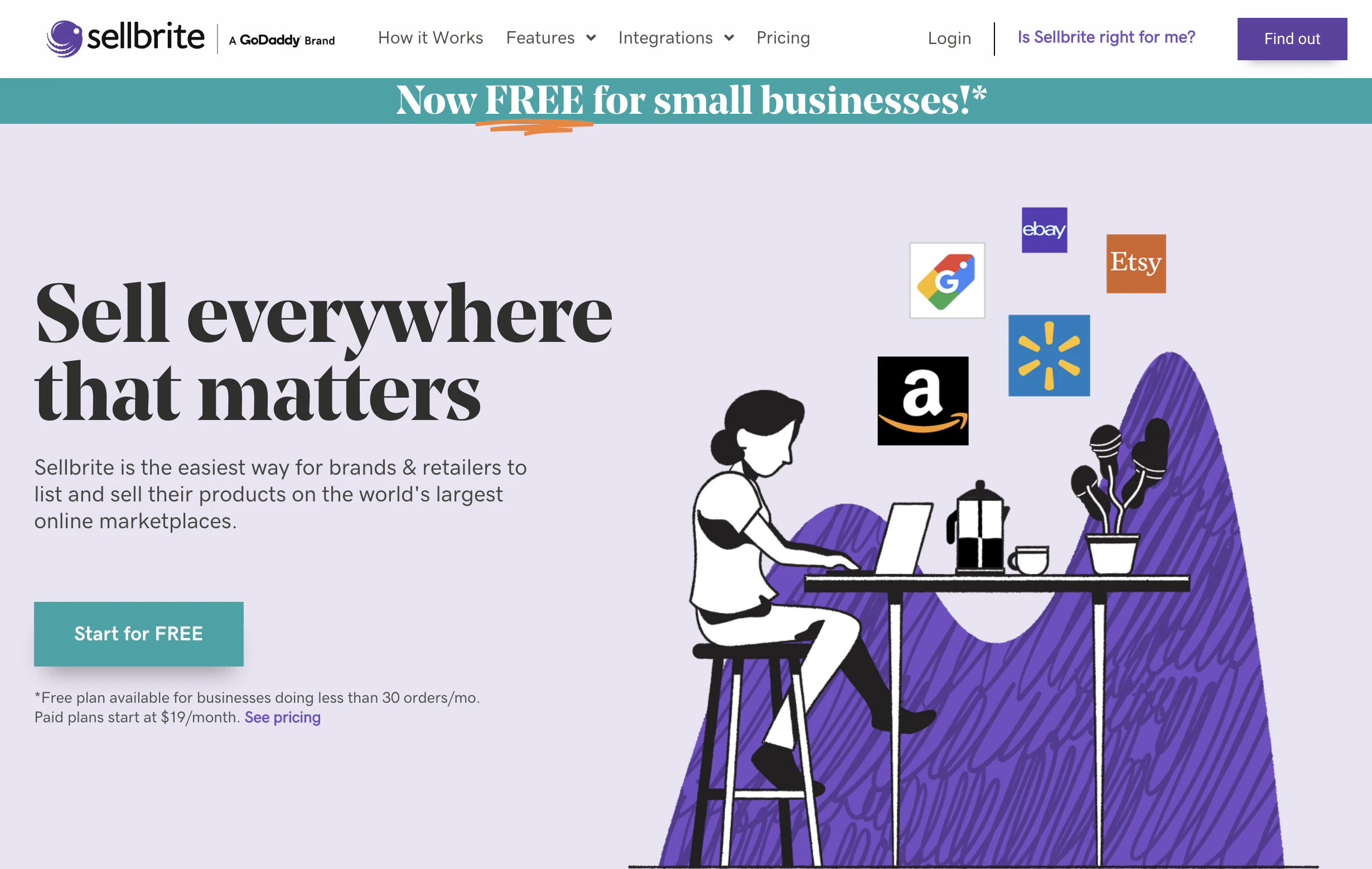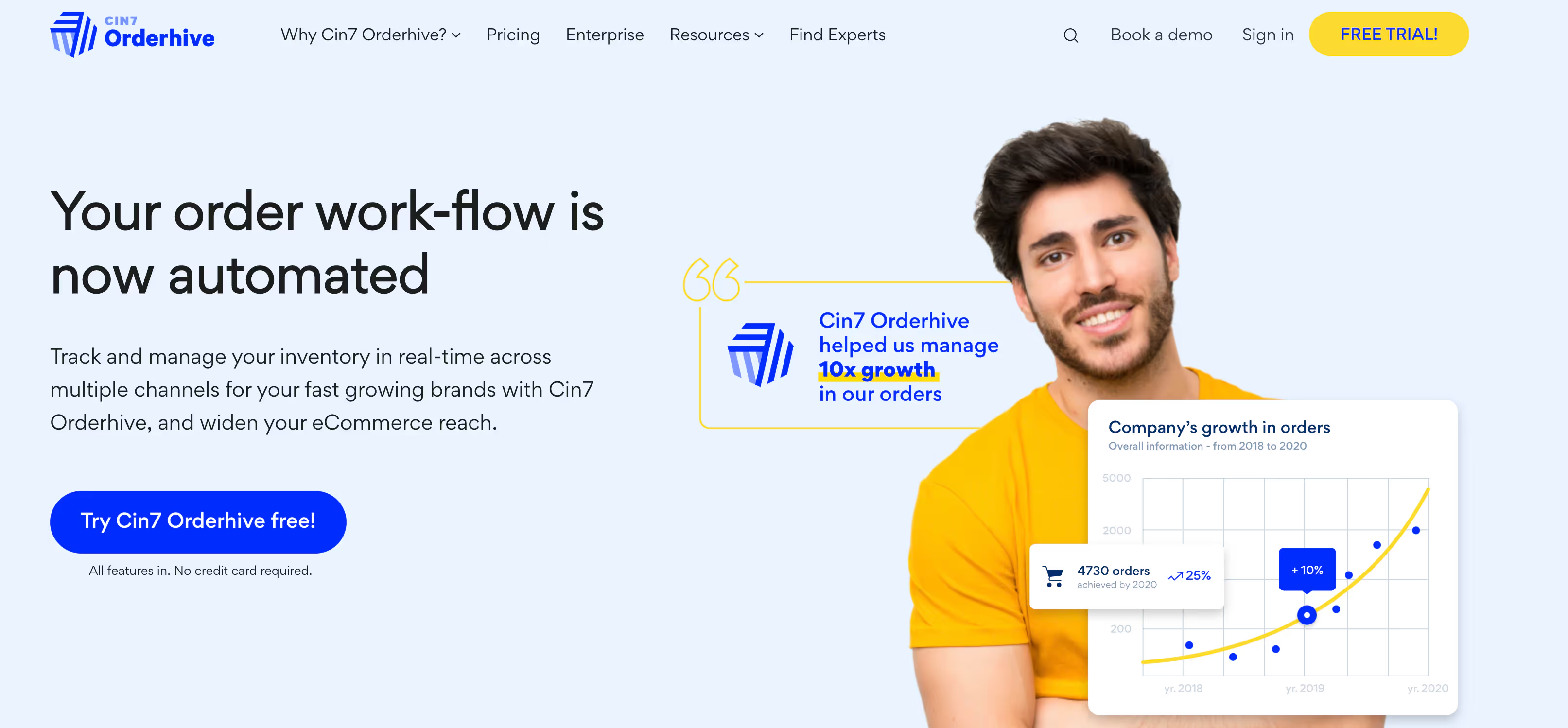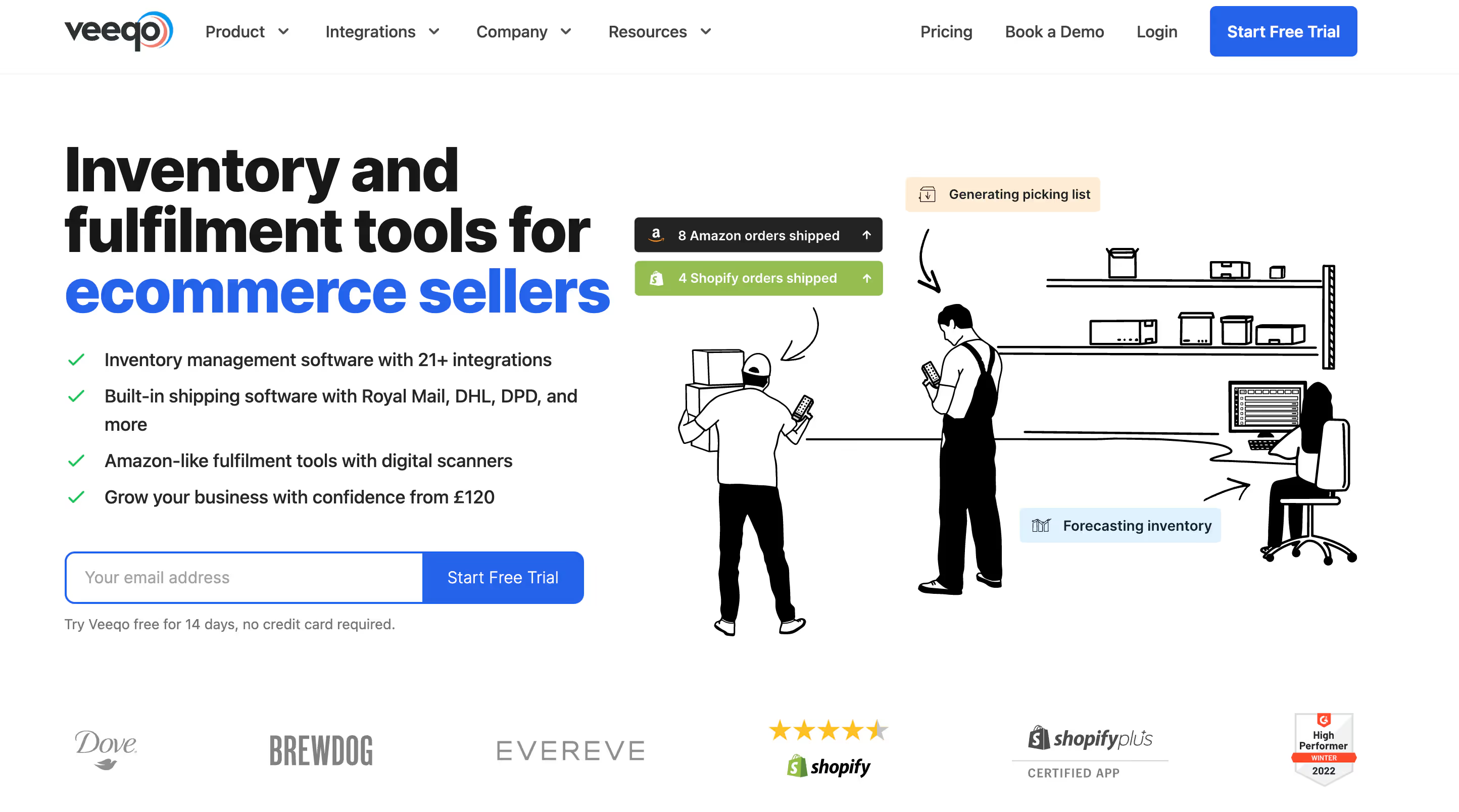Introduction
Amazon is both an essential part of any online retail strategy and a major challenge for sellers.
And one of the most difficult and important parts of selling on Amazon is inventory management.
Crucial to becoming an agile business and maintaining profitability, inventory management is a delicate balancing act. It’s about meeting customer demand and stocking the right amount of products.
I’ve outlined a few tips for managing Amazon inventory to help you launch (and keep) a successful online business.
Why Amazon Inventory Management is Important for Sellers?
If you’re new to Amazon, inventory management might not be your first priority as you start setting up shop.
The reality is, you need to nail down this strategy before your listings go live. And way before you even think about launching your first PPC campaign.
Here’s why:
- Attract shoppers and make sales. It’s understandable if you’re wondering “how does inventory management increase sales?” According to Amazon, sellers can increase sales by pricing products competitively, offering appealing promos, and using paid ads to drive traffic to the right pages.
- Meet customer demand. As orders start coming in, managing inventory manually becomes impossible. Inventory management helps you stay in control. It prevents you from selling products already claimed by someone else and ensures that you always have enough stock to keep pace with demand.
- Reduce inventory costs. Inventory management can help you save money from multiple angles. Because sellers know what items to restock and when to do so, they avoid spending money on products they can’t sell and overpaying for storage and warehousing. Additionally, inventory management gives sellers the visibility they need to make smarter purchasing decisions that can help them keep up with trends and take advantage of cost-saving opportunities.
- Reduce spoilage & inventory losses. Inventory management helps businesses avoid the costs associated with spoilage. This is especially important for those selling items like food, drugs, or cosmetics with expiration dates. Over-ordering leads to waste—both unsold products and the costs of storing and disposing of unused items.
The Link Between Inventory Management And Amazon Search Rank
Low inventory alone won’t tank your Amazon seller ranking. But, if your products are always sold out, click-throughs, conversions, and sales will fall.
If customers have nothing to buy, Amazon’s algorithm will prioritize your competitors. And, as a result, your rankings will drop.
How Do Amazon Reviews Factor Into Inventory Planning?
Most retailers understand that the critical role reviews play in converting customers. Yet few consider the impact poor inventory management can have on the customer experience.
Delays or shortages, for example, cause customers to become frustrated with their experience. And, frustrated customers will likely share their experience with the Amazon community,
If you run out of stock, that means you can’t make any sales. That means you miss out on potential product reviews that can increase your visibility on the platform.
Reviews act as a feedback loop that can provide deeper insight into what customers liked–or didn’t–about their product.
Those insights can inform your forecasting and demand planning strategies. They also help you determine which products to order, and what pages to promote.
5 Things You Should Know About Amazon Inventory Management
Technology can streamline inventory management–both on Amazon and off. Here’s a quick look at what you’ll need to build a strong strategy from scratch.
1. Make sure you have the right data. Data accuracy is key to effective supply chain management. It doesn’t matter what you automate, the algorithms won’t work for you without accurate insights and a connected data ecosystem.
2. Define how you’ll use the data and how it supports decision-making. According to Deloitte, holistic decision-making is a core competency for retailers, manufacturers, and the rest of the supply chain. What’s important to understand is, gathering data isn’t enough. Organizations must learn what metrics measure success and how to put insights into action.
3. Integrate data across all silos. Creating an integrated data ecosystem is the first step toward digitizing the warehouse and tracking the movement of physical goods. All sales channels, accounting tools, inventory management platforms should come together to create a single source of truth for all stakeholders.
4. Capture high-quality data in real-time. Real-time insights allow e-commerce brands to track changes and pivot before placing a big order.
There are several tools sellers can use to capture real-time data. For example, Amazon uses mobile barcode scanners and a network of connected sensors and devices to manage thousands of SKUs. This enables real-time visibility into inventory counts, sales data, and shipping demand at any given moment.
There’s also automatic identification and data capture (AIDC) which captures inventory data and automatically syncs it back to your ERP and other connected business tools.
5. Connect all facilities in a unified supply chain. E-commerce brands should focus on creating a consistent cross-channel experience. Chances are, you’re not only selling on Amazon, but you’re also selling on your website, Walmart, Google, eBay, etc., and you’ll need to make sure that all these channels “talk to each other.”
11 Ways To Improve Your Amazon Inventory Management
1. USE AMAZON INVENTORY MANAGEMENT SOFTWARE
Let’s be clear: using manual processes to track your Amazon inventory is a bad idea.
Not only is it time-consuming, but it’s also prone to human error.
Inside the Amazon dashboard, you’ll find a handful of reports that can help you track your inventory. Those with Professional Selling plans can Amazon Selling Coach, a tool that serves up personalized recommendations to help you move more products.
That said, you’ll also want to invest in a set of tools that bring more value to the dashboard and connect with other data sources and storefronts connected to your brand. Look for inventory management software that makes it easy to manage your Amazon store.
Inventory management systems are a category of specialized software designed to help you keep track of inventory levels based on real-time data.
You can use those insights to manage your inventory–orders and inventory counts are synced across platforms–preventing overselling, waste, and stock shortages, and enabling sellers to make data-driven decisions about inventory planning.
2. UNDERSTAND YOUR INVENTORY TURNOVER RATE
Inventory turnover is a ratio that represents how fast you’re selling through your inventory.
Inventory turnover allows you to measure how many times in a specific timeframe your company can replace the inventory you sold.
Understanding your turnover rate allows you to identify and fix problems within your inventory management strategy.
For example, low turnover rates imply weak sales and excess inventory—which means you may run into trouble when it comes to moving inventory. Low rates point toward a lack of interest in your products, an ineffective sales strategy, or they could be a sign that you’re ordering more than you need.
Faster rates, suggest that you either have strong sales or you don’t have the inventory needed to keep pace with demand.
Inventory turnover rates vary by industry. You tend to see higher turnover in industries focused on consumer-facing products that sell at a low price point–food & beverage companies, supermarkets, fashion & beauty retailers, booksellers, and so on.
To calculate your inventory turnover rate, you’ll need to find out how fast you’re selling each product line in your Amazon store.
The basic formula is: cost of goods sold/average inventory

While you can run the numbers yourself, the best way to predict your turnover rate is by using a forecasting tool that automatically tracks the sales trends across all platforms and product lines.
Amazon’s Selling Coach tracks sales against available inventory and makes recommendations for replenishing stock based on historical trends.
That said if you’re selling on other platforms like your website, Google, Walmart, or social profiles you’ll probably want to invest in a paid tool that offers cross-platform forecasting.
3. GET TO KNOW YOUR SUPPLY CHAIN LEAD TIMES
Supply chain lead time measures the amount of time between the moment a retailer places an order with a supplier and when the shipment is ready for delivery.
Knowing your supply chain lead times is critical to inventory management. This metric tells you approximately how long it will take to receive an order from a vendor and can indicate whether you need to take action to improve turnaround times.
Possible strategies may include:
- Increasing your order frequency. Increasing order frequency is one of the easiest ways to improve lead times. Rather than waiting to place a large order once every few months, you might place smaller orders more often. Make sure you check minimums and price breaks–you’ll want to figure out how much you’re saving by ordering in bulk and weigh those figures against the cost of stock shortages and delays.
- Giving suppliers access to sales forecasts. Sales forecasts help your suppliers plan ahead by giving them a sense of when to expect your orders. By providing up-to-date forecasts, vendors can anticipate your needs and may be more inclined to set aside your order in advance. For this to work, you’ll need to make vendor relationships a priority. If the partnership isn’t mutually beneficial, vendors have little incentive to offer the VIP treatment.
- Order from domestic suppliers when possible. Domestic suppliers can be more expensive than their overseas counterparts. However, ordering supplies from one state over means you’re dealing with much shorter lead times than products arriving on a ship from China.
- Consolidating suppliers. Here, the idea is that by consolidating suppliers, you spend less time coordinating shipments and managing vendor relationships. Consolidation also allows you to place larger orders, which may allow you to take advantage of volume discounts. Keep in mind, while working with fewer suppliers has some advantages, putting all your eggs in one basket can put you at risk.
4. CONSIDER DROPSHIPPING AS AN ALTERNATIVE TO STOCKING INVENTORY
You might also consider dropshipping instead of stocking inventory yourself.
Dropshipping means that a third-party manages and ships products directly to your customers when they place an order.
Essentially, dropshipping works as follows: the customer places an order and your storefront automatically sends the order to your supplier. From there, the dropshipping supplier packs and ships the order to the consumer.

While dropshipping can simplify the inventory management process, it’s important to understand the pros and cons that come with the territory.
Pros
- Low overhead
- Little upfront capital required
- Easy to get started
- Flexible
- Scalable
Cons
- Low margins
- Lack of control over stock levels
- Potential for supplier errors
- Working with multiple dropshippers can get complicated
5. BE STRATEGIC WITH PROMOTIONS AND SALES
Promos and sales are a great way to get customers to pull the trigger and make a purchase.
But you’ll need to be strategic about when you discount your wares–and how often–otherwise, you’ll run into trouble.
For example, a not planned promo can result in a sales spike that can deplete your stock before your next shipment arrives. As a result, orders get delayed, customers get mad, and well, your Amazon ranking takes a hit.
- Cap sales. One of the best ways to avoid this problem is putting a cap on sales. Once sales hit that threshold, Amazon ends the promotion and increases the price so that you can avoid running out. You can also include stock counts to create a sense of urgency–i.e. “don’t miss out.”
- Set time limits. If your goal is to sell out of a specific product, you’ll want to make sure you set a threshold that covers four hours of promotional sales. The reasoning there is, it takes Amazon up to four hours to remove a promotion after you cancel it. By building in that four-hour window, it allows you to make sure that you have enough inventory to cover any sales that come in after you stop the promotion.
- Order a reserve. Another option is ordering a reserve of promoted products from a supplier with a future ship date. This allows you to remove some of the risks associated with running a promo if you don’t have a ton of sales data to work with.
If the sale is a success, you can contact the supplier and have them ship the items ASAP. If things are a bit slow, you can push back the ship date. This allows you to make sure you meet minimums.
6. SLOW DEMAND FOR INVENTORY AS NEEDED
A successful promotion can bring in a ton of orders and increase brand visibility.
But if you can’t meet demand, you risk losing customers to competitors better prepared to meet their needs. As a result, your product pages will rank lower (in both organic and paid results), which makes it harder to attract new customers and sell products.
You’ll want to make sure you’re keeping a close eye on inventory count and consider increasing prices or pausing ad campaigns if a particular listing gets too hot.
Many inventory management tools allow companies to set thresholds that automatically trigger price increases to slow demand short-term so you don’t end up with a bunch of backorders you can’t fill.
Raising prices to slow sales can help you avoid stock shortages but it can also impact Amazon keyword rankings.
7. MAKE SURE YOUR LISTINGS AND INVENTORY WORK TOGETHER
Because there’s a close link between your inventory and how your products appear in the platform’s search results, you’ll need to optimize your listings.
What that means is, making sure you follow Amazon’s SEO best practices, i.e.:
- Clear, descriptive titles.
- High-quality photos that follow Amazon’s style guide.
- Descriptions that get straight to the point and address customer needs.
- Targeting keywords that match shopper intent.
You’ll also want to make sure that you’re using Amazon ads to drive traffic to the right SKUs to ensure a consistent stream of sales. And, that you’re following up with customers and asking for feedback. Ultimately, ads, reviews, and page optimization work together to boost rankings and reach a broader audience ready to make a purchase.
8. DYNAMIC PRICES MOVE INVENTORY
Amazon prices are always in flux.
Successful Amazon sellers know that static prices don’t move products. The goal is to align price with perceived value–and perceived value changes all the time based on factors like seasonality and demand.
You’ll want to create a dynamic pricing strategy that looks at all of the factors/conditions that could potentially change how a customer perceives the value of an item.
For example, how might the launch of the PS5 cause the perceived value of the PS4 to change? Or, how might demand increase around the holidays and drop off come January?
Amazon allows you to set custom rules to control pricing, though they might not provide the granularity you need to stay competitive.
Repricing tools can help you raise and lower prices as conditions change–using a set of pre-defined rules and algorithms to continuously update prices. Many of these tools pull data from other channels, so you’re working with more than Amazon sales data.
9. SET INVENTORY MINIMUMS TO MAXIMIZE PROFITS
Inventory shortages represent a major issue for retailers.
They frustrate customers and force them to look elsewhere to find what they’re looking for—which in turn, means sellers miss the opportunity to make a sale.
What’s more, the problem extends well beyond a temporary hit to the bottom line. Sellers that fail to meet customer needs will lose credibility, causing their reputation to take a major hit, causing their seller rating to drop and listings to appear further and further from the top of the first page.
Some sellouts are unavoidable, but most can be prevented with better planning (and the right technology).
By automating your inventory management strategy, you can use real-time data on sales patterns, listings, and individual product lines to replenish stock levels on-time and avoid inventory counts running too low.
10. INCORPORATE AMAZON INTO A CROSS-CHANNEL ENTERPRISE RESOURCE PLANNING STRATEGY
While inventory management is vital to Amazon’s success, it’s also just one piece of a much broader strategy. Big-picture, you’ll want to focus on building a strong enterprise resource planning (ERP) strategy that tackles every touchpoint along the supply chain.
The idea is, if you can optimize your inventory management process—you’ll save time and money that you can reinvest into other areas to drive growth–advertising, hiring, customer service, training, new product lines, tech upgrades, and so on.
Now, to do this right, you’ll (surprise) need to make sure that you have total visibility into your inventory levels, sales data, financials, and the external factors that influence demand. That said, it’s important to think outside the confines of the typical ERP platform.
These tools tend to leave out key insights/functions and focus on the financial side of supply chain management.
11. DON’T FORGET: YOUR CUSTOMERS MATTER MOST
Experience is crucial no matter where you’re selling your products, however, customers have higher expectations for Amazon.
Customers expect packages to arrive on-time and one small error can lead to bad reviews and lower rankings. They don’t care if they’re buying directly from Amazon or through a third-party seller–either way, they expect a consistent experience, fast turnarounds, and free shipping.
Your Amazon inventory management strategy, like your sales, marketing, and product strategies must be built around your customers. It also needs to evolve along with them: today’s sellers must respond to changing preferences and market conditions, change prices on-demand, and enter new channels without missing a beat.
10 Amazon Inventory Management Tools You Should Use in 2022
1. FBA
Price: Monthly costs vary based on shipping costs, storage space, and how many orders Amazon fulfills.
Fulfillment by Amazon (FBA) is a program that allows Amazon sellers to send inventory to Amazon fulfillment centers. The idea is, Amazon handles inventory storage, processes orders, and handles shipping and customer service. Sellers can manage inventory from the FBA dashboard where they’ll coordinate shipments, remove products from inventory, and track inventory performance.
Sellers are eligible for Prime 2-day shipping and gain access to Amazon’s global customer service network which can answer questions, process returns, and issue refunds. Amazon FBA isn’t a standalone solution. It only tracks inventory across Amazon’s warehouses not what you have in your own facilities or what you’re selling on other channels.
2. FBM
Price: Varies. FBM stands for Fulfillment by Merchant so your costs are dependent on which tools you use, where you’re storing your inventory, etc.
Unlike FBA, merchants using FBM (Fulfillment by Merchant) handle inventory management on their own. FBM gives merchants more control over the customer experience, costs, and savings. In many cases, it also offers higher profit margins. You’re not paying Amazon to store and ship inventory, which means you’ll keep a larger share of the pie.
Conversely, you may end up paying more in overhead fees. Sellers without fulfillment and warehousing solutions in place, the upfront costs of FBM can be staggering.
Additionally, not every listing product qualifies for Prime—something customers now expect from every Amazon purchase.
Amazon offers an FBA Calculator, which can help you compare the costs of using FBA vs. FBM.
3. SELLBRITE

Price: Free for small businesses processing up to 30 orders per month. Paid plans start at $19 per month.
Sellbrite is a multichannel e-commerce platform designed to help you manage storefronts across the web—that includes Amazon, as well as Shopify, Google, Walmart, Etsy, and even Sears. The platform allows you to list your inventory on several channels at the same time. It syncs inventory counts across all platforms to prevent overselling.
Sellbrite also allows you to print discounted shipping labels and ship all your orders from a single interface. Or, you can opt to route incoming orders to your Fulfillment by Amazon (FBA) account.
4. ORDERHIVE

Price: Free plan available to Shopify users. Paid plans range from $44.99 per month to $269.99 per month. Custom enterprise plans available upon request.
Orderhive is an inventory management platform that aims to automate your cross-channel order flow. This software allows you to track inventory levels across all connected platforms and syncs data in real-time anytime you make a change. Orderhive also incorporates customer feedback into the platform, creating a direct line between customers and the inventory behind the products they care about now.
5. SELLICS

Price: All-in-one plans start at $99 per month. Users also have the option of paying for standalone modules (SEO, PPC, or Profit Management) if they don’t need the full package.
Sellics is an all-in-one tool that focuses on the five key areas that work together to create a successful Amazon strategy. The feature suite targets the following strategies: Amazon SEO, inventory management, PPC, profit management, and customer reviews.
6. VEEQO

Price: Plans start at $195 per month, with the option to pay annually for a 20% discount.
Ideal for cross-platform inventory management, Veeqo markets itself as a single source of truth for all e-commerce fulfillment. The app focuses on four core areas: inventory, picking, shipping, and reporting.
Veeqo integrates with all channels, carriers, inventory management tools, and anything else in your tech stack. Amazon sellers benefit from inventory-specific tools like inventory automation, forecasting, reporting, and product management.
7. QUICKBOOKS COMMERCE

Price: Plans range from $39 per month to $599 per month, though users can save up to 20% when billed annually. Larger businesses also have the option to create a custom plan based on needs.
Quickbooks Commerce (formerly TradeGecko) is an inventory management platform that allows users to track products and stock levels across many channels and warehouse locations. The platform’s inventory management features make it easy to set up automatic stock updates, sync “on-hand stock” to all connected systems, set up reorder points, automate demand forecasting, and more.
8. BRIGHTPEARL

Price: Pricing available on request
Brightpearl is a retail operations platform that integrates with a range of channels—including Amazon. The platform is ideal for multi-location retailers that sell on several online channels.
Features help teams optimize warehouse operations, demand planning, and internal workflows.
Brightpearl integrates with top accounting tools, allowing you to use real-time financials and sales data to inform your inventory planning process.
9. TEIKAMETRICS

Price: Pricing available upon request. 30-day free trial available.
Teikametrics is an AI-enabled platform designed to support Amazon and Walmart sellers. Unlike some of the other entries on this list, Teikametrics focuses on optimizing ad performance on both platforms.
Users can link Sponsored Product campaigns to specific goals, keywords, and to-dos.
While this platform doesn’t manage inventory counts, it can help you improve ad performance and increase visibility. Its data-powered algorithms help you understand customer behavior and intent so you can move more products and improve your listings.
10. LINNWORKS

Price: Pricing available on request.
Linnworks is an e-commerce platform that helps sellers manage their inventory across multiple storefronts and warehouses, automate processes, and sync data across all connected channels. The platform offers real-time inventory and sales data, enabling smarter decision-making, as well as several tools designed to optimize Amazon performance.
Desired Outcome
Amazon may be a giant, but it’s important to remember that it’s one platform, not a business model. You’ll want to look for an inventory management tool that enables you to manage stock across all channels. That includes Amazon, but also eBay, Walmart, Google, your website, etc.
That way, your inventory and listings—regardless of platform—come together to create a seamless experience.
That “omnichannel approach” puts the focus on the customer and the brand, not the platform. It also protects against algorithmic shifts and penalties that can bury your listings and tank your financials.
Final Thoughts
For e-commerce brands, Amazon offers a ton of promise. Retailers have an opportunity to extend their online presence and boost their bottom line–that is if they can nail down inventory management.
Again, success comes down to data.
You’ll need an integrated ecosystem that can sync data between platforms, and tools that can streamline and automate the inventory management process–allowing you to respond to changes in real-time without the risk of making a costly mistake.
Trust your Amazon business to a 7-figure Amazon Marketing Agency that will scale your brand or send your money back!














.webp)

.webp)








.webp)









































.webp)






